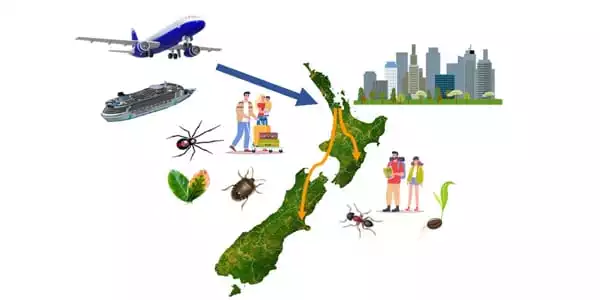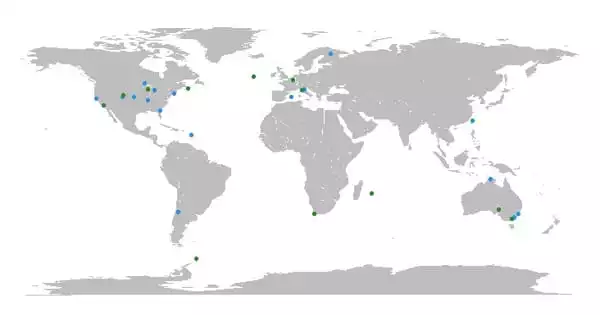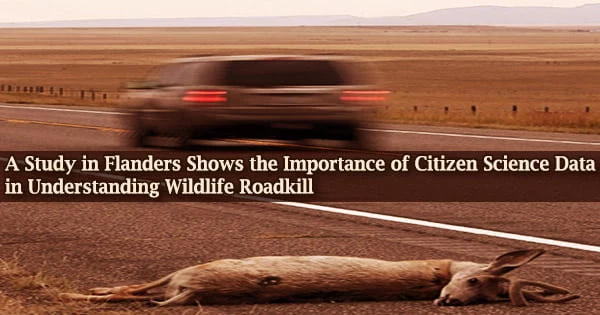Invasive species have the ability to establish and spread quickly, reducing biodiversity and destroying habitats that support entire ecosystems. Invasive plants can displace native vegetation, reducing wildlife forage, severely damaging riparian areas, destabilizing slopes, and increasing fire hazards. Invasive animals can outcompete native species for food, shelter, and space, as well as spread diseases, parasites, and disrupt food webs. Invasive species also have an economic impact by causing infrastructure damage, reducing crop yields, destroying forests, and costing millions of dollars in management and control costs.
Exotic species dispersal can be aided by international tourism. A new analysis of data from tourism accommodations and exotic organism detections in New Zealand reveals that levels of detection are significantly correlated with international and domestic tourist movement, even when population levels are considered. There was no discernible difference in risk between international and domestic tourists, indicating that tourism as an activity is associated with the introduction and spread of exotic species.
Tourism is a significant economic driver of the global economy, contributing significantly to the income of many countries. However, tourism can also contribute to the introduction and spread of unwanted exotic organisms across borders, such as insect pests or weed seeds. These can be detrimental to the natural environment and agriculture, resulting in social, environmental, and economic harm.
The main takeaway message is that within-country tourism movements are significantly correlated with the detection of exotic pests. That is, both tourists and returning residents bring bugs into the country, and both are responsible for spreading them once they arrive.
Dr. Andrew Robinson
Tourists, albeit unknowingly, may aid in the spread of such unwanted organisms and their conquest of new lands by transporting them in their luggage or on their clothes and shoes. In 2011, a New Zealand study discovered 2.5 plant seeds, 41 roundworms, 0.004 insects and mites, and many microorganisms, such as fungi that could cause plant diseases, for every gram of soil on the footwear of arriving international passengers. Furthermore, these organisms were alive, and some of them had previously been identified as biosecurity threats. Tourism, it should be noted, can introduce risk in two directions: the arrival of international visitors and the return of residents from international travel.
The question is, to what extent do they play a role in the spread of exotic organisms? A study led by Dr. Andrew Robinson of the University of Melbourne’s Centre of Excellence for Biosecurity Risk Analysis and Mark McNeill of AgResearch New Zealand seeks to answer that question.
To do so, the researchers compared data on exotic organism interceptions in New Zealand to accommodation data for international and domestic tourists, while accounting for the country’s population distribution. The study, which was recently published in the open-access journal NeoBiota, spanned the years 2011 to 2017, and the exotic organisms discovered included insects, spiders, mites, snails, plants, and roundworms.

Robinson and McNeill discovered a significant relationship between levels of incursion detection and tourism accommodation records: the number of nights spent in hotels was found to be significantly correlated with the detection of exotic pests during that time period. Importantly, the study found no statistically significant difference between the effects of international and domestic tourism, demonstrating that even domestic travel can aid in the spread of exotic species. There was also a significant positive correlation found between the detection of exotic organisms and population numbers in various regions.
“The main takeaway message is that within-country tourism movements are significantly correlated with the detection of exotic pests,” the researchers wrote. That is, both tourists and returning residents bring bugs into the country, and both are responsible for spreading them once they arrive. They recommend that biosecurity authorities continue to devote resources to the management of invasive species and pests spread by tourists and their activities.
They do, however, highlight the biosecurity risk posed by other potential pathways for exotic organisms, such as sea freight. They conclude that comparing the various methods of introduction and dispersal would provide a better understanding of relative risk.
Invasive species have a direct impact on the tourism industry by wreaking havoc on BC’s ecosystems, wildlife, and infrastructure. Tourism is also a major source of invasive species introduction and spread. Invasive species can be spread by people who engage in activities such as fishing, boating, hiking, camping, and moving between sites. These activities also take visitors to environmentally sensitive areas such as parks, biodiversity hotspots, and remote wilderness areas. Invasive species can attach themselves to clothing, animal fur, camping gear, firewood, vehicles, and watercraft and be transported to new areas.
















